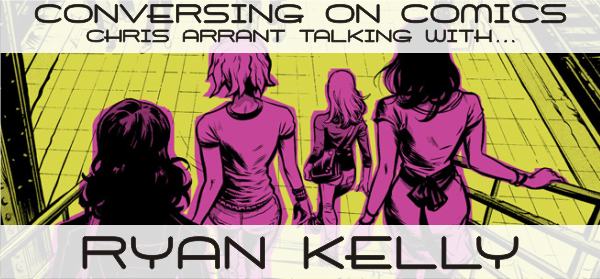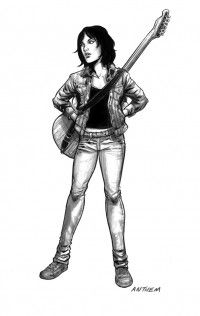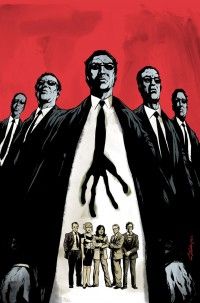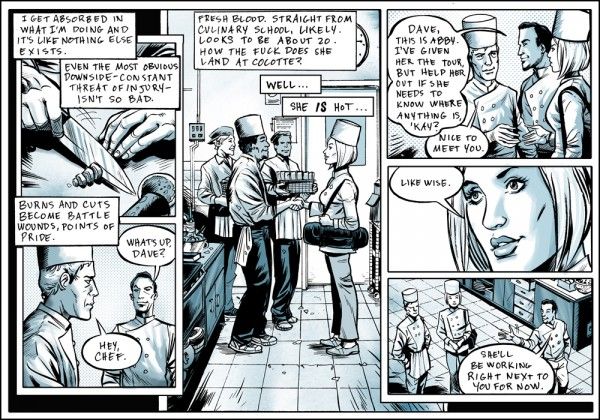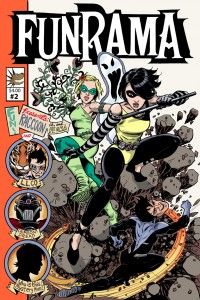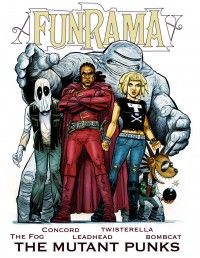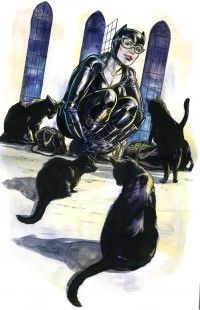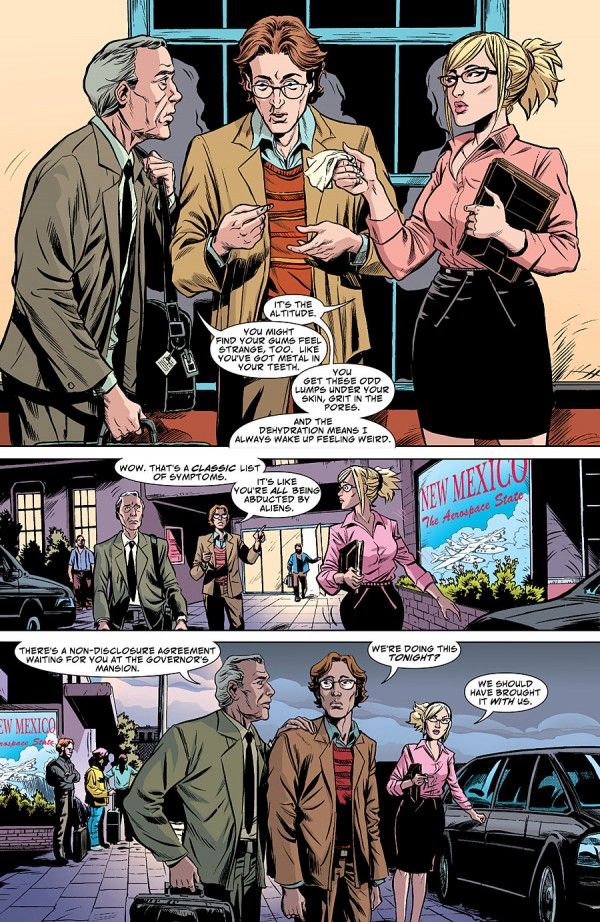Being a comics creator is not unlike being a musician: You start out on your own, working out of your garage, and you meet up with other liked-minded souls and try to make a go of it with projects. Some ascend to being the comics equivalent of U2, while other flow in and out of the independent and mainstream scene as their wills, and their fans, take them. Some mainstream creators wish they were considered more "indie," while some independent creators might want to try some of that mainstream Top 40 hit genre they grew up on, while not forsaking their indie roots.
Artist Ryan Kelly wants to do a little bit of everything. Kelly broke into comics as a graduate of the Minneapolis College of Art and Design and Peter Gross' inker/assistant/finisher on books like Lucifer and Books of Magic. After doing his first major work with the graphic novel Giant Robot Warriors, he came into his own beside Brian Wood on the epic 12-issue travelogue/memoir Local. Since then the two have re-teamed for stints on DMZ and Northlanders and on New York Four and its sequel New York Five. Earlier this year Kelly partnered with Paul Cornell for the Vertigo ongoing series Saucer Country, Kelly's first as a lead artist. But Kelly's not content to just do one thing -- he also balances a weekly foodie webcomic called Cocotte with writer Kat Vapid and his own self-published comic Funrama, as well as several other projects in the works.
And if that wasn't enough, he wants to draw superheroes. You hear that, Marvel and DC?
What follows is an expansive conversation between Kelly and myself where I ask him questions I've been wondering about for years and ones springing out of his most recent endeavors.
Chris Arrant: Let’s start with an easy one: What are you working on today?
Ryan Kelly: Oh, good, a nice softball question right off the bat! Right now, I'm desperately trying to get a new issue of Saucer Country finished. I got my self in a situation where I have to pencil and ink an entire issue in 10 days. I haven't been sleeping. It hurts. But I've done this before. No problemo.
What specifically is on your drawing board right now -- right this moment?
[Laughs] I can't say specifically what I have on my lap desk this very second because we haven't announced it yet. But I'll tell you a few things. I'm working on layout for a new comic. It's a scene of a girl playing guitar. The project is with a writer I've worked with before. The comic will be a digital format delivered in a way I don't think has ever been done before. I'm working on it as fast as I can in hope that we can launch it in a couple months.
You’ve got a lot of projects going on at the same time: Saucer Country for DC/Vertigo, the webcomic Cocotte, your own print comic Funrama, this new "girl playing guitar" comic you just mentioned, and some more projects you mentioned on your blog. Is this busier than you’d like, or is this the ideal situation for a freelance artist?
Hmm, I don't have an easy answer there. I don't want to suffer. I want to sleep and spend time with my family and have time to go to the bathroom. But this is just the way it is. Saucer Country is very taxing, as it should be. I'm doing full art, and having a book ship late is unacceptable. I made the choice to launch Cocotte now because I get really antsy about projects. I want them out there. I can't stand the preliminary stages. I hate doing "pencils" and character designs. "If it's good, just get it out there," I say. And I thought Cocotte was ready. Funrama is an ongoing, but it's a lot of work because I'm doing everything. I'm building the whole world from the ground up. But I have to put it away when other deadlines come up. And, I'm currently developing two new huge series with two really huge writers. One of them is someone I've worked with before. The other writer is just huge. Everything is huge. Mclargehuge.
So, the short answer is I would really prefer to be less busy just so the quality doesn't get compromised, but, I'm used to being busy. My art seems to thrive in these tight situations.
Has there ever been a time for you where you only had one solid commitment (i.e. job/assignment) you were working on instead of juggling multiple projects? Is that even something you’d like to do, or do you prefer having multiple things going so if one drags then the others are still going?
I don't ever remember a time that I've worked on only one thing at a time. Not since high school. I think it would be nice. The art would be better. My attention span is a lot shorter now that I'm older. I prefer to work on many shorter-length pieces, whereas in college I would work on one painting for a month. I'm fast and I can work on a lot of things at a time. I've had 3-4 comics going this year. If I had a proper studio space, I would have assistants working every day.
But I take on a lot of work because I feel that it won't last forever. It saddens me to see older creators fall out of favor and lose work over time. It concerns me that comic book careers are like baseball careers: You have 10-20 good years and then hot, young, new artists come in. I think that's lame. And cruel in a way.
The main thing on your plate right now is Saucer Country – your first ongoing series. Now that five issues are out and you’ve been working for this almost a year now, what’s it like carrying this series and introducing it in the current market?
Paul Cornell was developing Saucer Country at Vertigo for some time and eventually editor Will Dennis called me up and offered me the job. I took it. The end. But then I had to draw it! I'd be lying if I said I wasn't intimidated. I wasn't intimidated by the workload. Seventy-five issues of Lucifer was good practice, and I'm perfectly conditioned for monthly comics. But this was a higher profile project for me and, naturally, more responsibility. More people will be judging my art. Plus, launching a new title is tricky these days since it's so much about that first issue. That first hook. But, I was up for it. I was in love with Saucer Country at first sight. The characters were wonderful and I knew I could do great things with them. Saucer Country truly felt like a book I've been waiting to draw since I was a little kid. I was really into the alien stuff as a youngster. I'm so proud of the work we've done on Saucer Country so far and the best is yet to come.
What’s it like, being an ongoing? Although you worked on ongoings before with Lucifer, you’re carrying it here with Saucer Country -- and unlike miniseries it’s a long-term open-ended commitment that could go on for years if it goes well. What’s that like to commit to something that could be that big?
Honestly, I don't think about it. I just put my head down and draw. If it goes on for 5 years, that's great, I'll be there for the ride. I was a little reluctant at first just because I don't like being in the spotlight. I just want to draw, collect a paycheck and feed my kids. And I flat out rejected the idea of doing covers, which was odd because it used to be my dream to be a cover artist. It just seemed like too much for me to handle. But now that I'm doing them, I relish each new cover. I'm looking at old 90's Vertigo covers for inspiration and I admire how each cover would look wildly different from the next. A lot of artists I consider my peers had gotten ongoing series and now I had finally received a shot at one of my own. Plus, The subject matter was right up my alley, as I was really drawn to the paranormal as a kid. Saucer Country was too good of an opportunity to pass up, never mind the fact that I need a steady paycheck for my family.
Your second big project is Cocotte, updating online every Monday. How’d you get involved in this real-life kitchen drama?
Kat Vapid is a great writer. The problem is, nobody knows it yet. So I was intensely determined to collaborate with her and get a comic out to the public so they could see what we are capable of. I asked her to give me something to make into a comic. Cocotte was originally just a throwaway story, but she reworked it and structured it into traditional comic panels and pages. I don't remember asking her to produce me a "story about cooking"; I just asked her to get me a story -- any story -- as long as it was something we could extend and serialize.
I think it's worked out well because she has worked in numerous kitchens over the years and I believe her perspective has illuminated Cocotte and it feels real and authentic.
Are you learning things about cooking and kitchens while drawing this? Are there instances where you have to ask Kat to elaborate on specific directions/explanations in the script?
Yes, I really am learning a lot. Maybe too much. [laughs]
After slaving away in the kitchen for 8 hours, Kat Vapid will tell me some outrageous stories. Some stories are too R-rated for this interview. I mean, this is Kitchen Confidential stuff, ha. The things that go on between co-workers in the restaurant environment is pretty intense and salacious. Sometimes she'll tell me about some fight that broke out or something, and I'll say "you have to put that in the comic!".
Have you examined more closing your own cooking once you got into the mindset to do Cocotte?
I'm a foodie in the sense that I go to nice, authentic restaurants, but I don't cook, myself. I was raised on hot dish and jello marshmallow salad. At home, I eat hot dogs wrapped in Wonderbread.
Artistically, I was inspired by Japanese food manga like Oishinbo which has sold millions apparently. I really like how Oishinbo artist Akira Hanasaki draws the people crudely but the food is rendered with great care and detail. I've noticed a large wave of western food comics this year. I didn't anticipate that when we started Cocotte. I just want to draw good stories and Kat is writing what she knows. She writes fantastic character interactions. Cocotte is very easy and seamless for me to execute. I really feel that it's a comic that speaks for itself.
Has drawing such a food-centric comic made you hungry for some of the things you’re drawing?
Not really. I think I need to do a better job drawing the food. And, we're lacking color. I think color would help to make it all more appetizing. I only have about four hours to do each Cocotte page so full color was just not possible. Right now, Cocotte has focused mainly on the human relationships but I hope to achieve a proper balance between food and the relationship stuff.
Funrama #2 just came out, but for a lot of people reading this they may be out of the loop. How would you describe that self-published series, especially in relation to your more recognizable work?
Funrama should be my more recognizable work, but it's not. Maybe I don't want it to be? Maybe I don't care if anyone reads it? Funrama is very special to me in a way that no other creator-owned property could possibly be. It's my grand comic book opus and i'll be making it my whole life.
Funrama is very much my Fourth World, speaking of Jack Kirby. Roughly put, It's about a superhero team that is assembling to defend a magical island in the Bermuda Triangle that is the source of a special power. I can't say what that "power" is yet because it will spoil the story. The island is going to be attacked by a menacing monster named Mantaboy. It's going to be really exciting. Right now, it's very much like Seven Samurai meets Wizard of Oz with lots of superheroics and sci-fi fantasy thrown in. The 2nd issue showcases the first official member of the team, Raccoon. I used the first issue to introduce the Mutant Punks which are an anarchic group of pirates. Since I didn't have a publisher, I didn't have to follow the rule in which the first issue sets up the main character and ends with a trendy cliffhanger. I used the first issue to introduce minor characters! The Mutant Punks are just a band of idiots that pass through from time to time and blow stuff up. It was so exciting and liberating to just do what I want and not follow these formal rules.
Everything in Funrama -- the plot, the setting, the characters, everything -- I created in 1986 when I was about 10 years old. The comic ran for about 50 issues until I canceled the series at the age of 15 or so. I made copies and shared them with friends and classmates but it was primarily my own creative vehicle and it did its job keeping me busy and sharpening my storytelling skills.
So to go back to my first point, Funrama is a comic I'm making for me. It's a secret comic I share only to those that seek it out and press the "Buy Now" button.
You said you did about 50 issues of this as a teenager. What’s it like to carry that with you and revise and revise for years before putting it out to the public?
It has made it a whole lot better! I almost launched Funrama in 2000 and I have a Preview #1 issue to show for it. I have visual evidence that I created Funrama before the TV show Lost, which shares some of the same plot points and concepts. I almost launched Funrama again in 2008 when I was formally pitching it to publishers but they were either not interested or required a lobotomy to fit their publishing model, which is fair enough. Going around and pitching Funrama was not fun. Saying "Hi, my name is Ryan Kelly" to editors at conventions and getting blank stares was not fun. But in the end, it was good. It helped me mature and grow a thicker skin. And most of all, it led me to look at my own creation and realize that it's not as good as I thought it was, which is a considerable obstacle for every creator.
What led you to want to do something like Funrama? It seems far different from your other creator-owned work you’ve drawn.
Sometimes, comics aren't fun. I wanted to do something that was, principally, to it's core, all about fun. I'm very proud of all the creator-owned work I've done with various writers these past 10 years - and most of it is creator-owned -- but I wanted to have something that was all mine; To experiment with and push the creative envelope. So, that role fell on Funrama.
Let's circle back around and talk about something you mentioned earlier -- you opted to diverge from the standard model of introducing the lead character and doing a cliffhanger in the first issue. Why'd you do that?
I think that was a huge experiment and it was primarily done for laughs. That's something I would never get away with if I was with a proper publisher. Oh, yeah ... and also ... The Mutant Punks blow up the Mall of America and The White House and attack people for no reason. That would all get edited and watered down and Funrama would just follow the same traditional format that I feel gets stale in mainstream comics. Funrama #1 Presents: The Mutant Punks was a violent reaction to that. [laughs]
Funrama #2 Presents: Raccoon, in reaction, was played more straight-forward. It was a straight-on superhero comic. It could have been a Supergirl or Batgirl comic. I did it to show everyone that, yes, I can do this style too. Funrama #3, in turn, well be completely different as well.
And for getting this out into the world, you’re self-publishing it and only doing 400 copies. Why do it yourself, and why such a small print run?
It's partly indecision and partly a lack of resources. On the resources front, I just didn't have a publisher backing me up. I don't have anywhere to store thousands of units, so printing 400 copies was the only sensible option for me. I don't have a storage space and I can't pay for one. As for the indecision, I didn't know what the demand would be for Funrama. The single issues were initially meant to be just convention-exclusive items, that's why I load them up with pin-up art. Later, I opened them up to mail order. But, shipping just obliterates my profit margins, especially when an international buyer comes along. Now, Funrama #1 is sold out and I'm not going to do a third printing (I've sold about 900 copies). So, I'm trying to figure out what to do. I'll either offer it for free or try to get it on comiXology or something. I hope to have Funrama collected when I get further along.
Years before you were drawing comics, you were inking them for Peter Gross. You haven’t actively been an inker for years, and I’ve also noticed you’ve rarely had someone else ink your work. Why is that?
It's not a deliberate choice. The funny thing is, I don't care what I'm doing as long as I'm making art for a living. Doing full art is a practical choice as much as a creative one. I'm just much faster when I'm doing full art. Penciling "tight" is such a waste of time when I'm on full art, But I can pencil super tight when working with an inker. I did finishes on an issue of The Unwritten and Peter will just give me a few profile outlines. That's all I need! Working on Lucifer for five years really honed my speed and technical proficiency.
Flipping it, do you think you’d be capable of doing what Peter did and give you a page with just a few profile outlines over to another artist to ink and do finishes for your work. Is there anyone you trust enough to do it?
I don't think so, not yet. When I did finishes with Peter, I never thought about my own work. It was just getting the job done. Peter is a great artist and I knew his style and became really familiar with it so I adapted and mimicked it. Now, when I do my own layouts, I see his design style in mine. If I'm working on a serious deadline job, it doesn't concern me who inks my work. The great Jim Rugg came in and inked 10 pages for The New York Five because the deadline was pretty serious. But, overall, I usually find amateur inkers to be really plain and heavy-handed with their inking which doesn't translate into what I want.
I’m sure you must have at some point, but have you ever worked with Peter with you penciling and breaking down the page and Peter inking?
Not that I recall. The work we did was very fluid. Although, he inked most of the main figures and faces, at least at first. Any Lucifer page could be 10% Peter and 90% Ryan or 90% Peter and %10 Ryan.
You’re one of the few artists working in the mainstream industry who’s made his name without doing superheroes. The closest thing I can find is a short you did with Peter Gross with Cloak & Dagger for Marvel And Funrama might count, too. But essentially, no capes for you. What’s that like for you?
This is the question I've been waiting for! I want to draw superheroes, I really do. I think I'd be good at it. I just haven't gotten the call. In my heart, I'm a DC guy, but I grew up as an X-Men freak and I think I would be really good on all that stuff. I think I'd do well on some Bat-family stuff and I love the Lantern universe. I don't know what to say. I have this fear that when editors on the big jobs think of me, they think of Local, and just see this weird, inky art with weird looking people. But I can do anything. Although Local is my greatest achievement, I'm afraid it pigeonholed me as "that indie black-and-white artist that draws that way." But, It doesn't matter. If I had a choice to draw Uncanny X-men or Saucer Country, I'd choose Saucer Country. Saucer Country is a perfect match for what I do. It's a dream job. I just want to work with people that truly want to work with me and like my art. It doesn't matter if I'm drawing Batman or Arcadia Alvarado.
You say you’re a DC and a X-Men freak. Your drawings of the X-Men, Kitty Pryde in particular, are pretty memorable. Are there certain characters, teams or creators you’d love to jump on and do some comics with?
Just to be clear, I would rather work with certain writers than certain characters. I'm sure if I thought hard enough, I could come up with a Top 10 List of Writers I want to work with. But that's my special secret. I don't want to reveal who I have crushes on. Brian Wood is on that list though. [laughs]
As for characters, yes, I love the X-men but I don't think I've read an X-men comic in 20 years, with the exception of Grant Morrison's run. I was a heavy collector in the 80's and I nearly own the whole run of Uncanny X-Men #1-300. I was the only kid in my school that was buying old 60's silver age copies with my allowance. I believe, as an artist, you are deeply shaped by whatever you absorbed at the age of 16 and that sticks with you. At the time, I loved Chris Claremont's Uncanny X-Men with John Romita Jr., Jim Lee and Marc Silvestri whose work I really loved. I read that, Batman, and lots of unconventional black and white indie stuff.
I'd love to draw some Bat titles and X-men. I love the Doom Patrol, Jonah Hex and any Lantern stuff. I'd be really good on the Red Lanterns. I know them all by name. Sinestro Corps, Larfleeze, the Indigos, the Star Sapphires. I never get tired of drawing them for some reason.
I've only gotten the chance to draw one 10-page Batman 80-Page Giant story with Paul Tobin featuring Catwoman and Riddler. It was a lot of fun, I hope I can do something like that again.
We hope you enjoyed our chat with Ryan Kelly, and will come back next Friday when Chris Arrant interviews journalist-turned-editor-turned-writer Ian Brill. Ian Brill's got a lot to talk about, from his days editing at Boom! Studios to his transition into writing with Darkwing Duck and Freelancers and on to his first creator-owned self-published series Dracula World Order.

